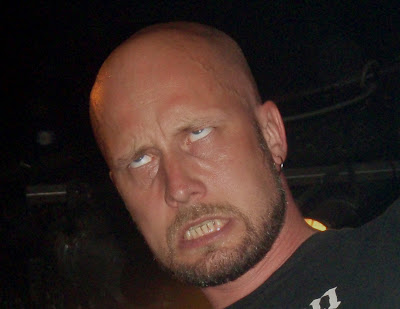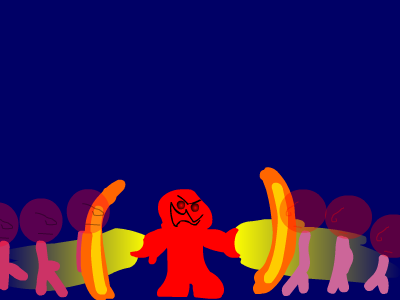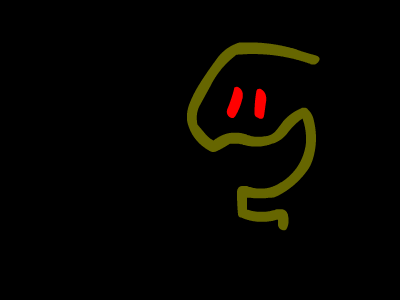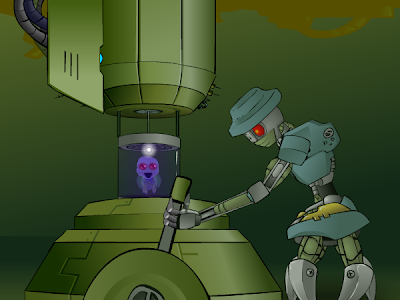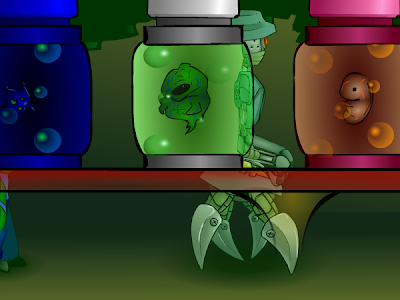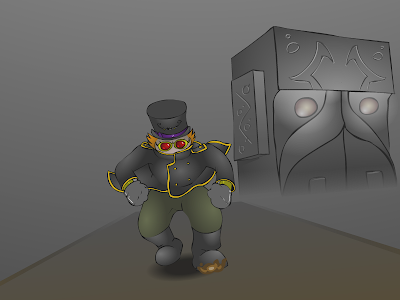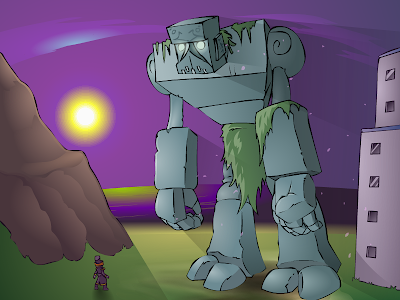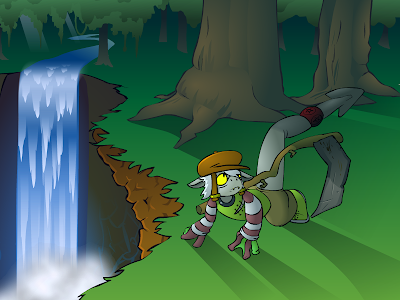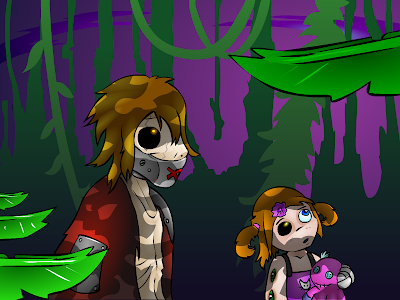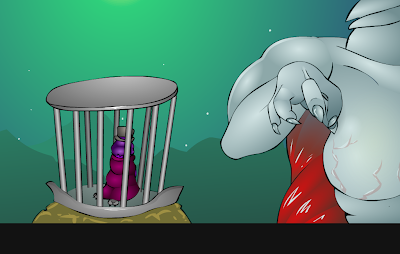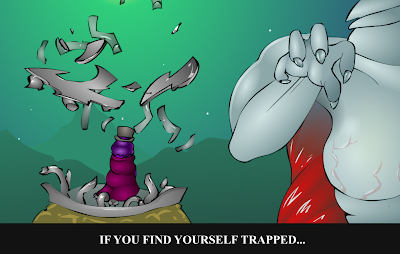Here's something I've been contemplating for a while.
I believe animation is a medium, not a genré. I feel the same way about each
method of animation - stop motion, 3D, 2D traditional, 2D digital (ToonBoom and Flash), scratching onto the film, whatever.
It's frustrating when the commoner (or as the case may be, the Hollywood bigwig handing out the movie deals) lumps all movies or works of a medium into one neat little package - for instance, 3D movies for a while were synonymous with 'Animal movies'. Madagascar, The Wild, Ice Age, Happy Feet, Over The Hedge; it seemed like everywhere you looked there was a 3D movie about animals and it made me rage. It's a good medium, why let it go to waste? Because it's easier, or cheaper? Are you kidding? It's 3D, you can do whatever you want with it!
This happens of course with just about every medium and submedium in the animation industry, and not only that but it happens in art, too. There have been painters for a long time who make good money by making photoreal portraits of their subjects - when really you could just hire a photographer with a really good camera to do the same thing. I don't consider this a bad thing - as an artist, I can understand the viewpoint that painting something that could easily be mistaken for the real thing is the final destination of 'detail' painting, the opposite of impressionism or minimalism, and the king of that arena. There is a reason painters tried to replicate photos.
In the animation world, this medium-copying is practically fetishised. It permeates everything. Once upon a time it was a technique - the limitations of 2D in the 80's and virtually every point in time before that made the use of digital special effects impossible, requiring 2D animators in some cases to replicate a 3D look.
I can think of an example in Rock 'n Rule; the cars, to look more believable, were filmed models which were then rotoscoped by the 2D animators to keep the shapes consistent (and I don't blame them, as vehicles in motion are about the most difficult thing I can think of to animate).
But now it seems to be done for the sake of itself. "Look what we can do!"
Corpse Bride, while a fun movie, bothered me in a few ways and one of them was the fact that they couldn't make up their minds over whether they wanted it to be stop motion or 3D.

Now don't get me wrong, it's a pretty good movie (I didn't like the beginning or end scenes but everything else was fantastic), and I am all for adventurism with animation techniques. But there was a really odd method of attack for this piece that leaves me wondering, 'why?'

If you've done any research on this movie and how it was made, you'll know that they did not use the usual head / mouth-swapping method typical of the "Tim Burton" animated movies. Instead, there was a very complicated device installed in each puppet's head that allowed the animators to use a key in the back of the puppets' heads (hidden in their hair so you couldn't see them). This allowed gradual contortions of the face shapes so that the animators could get to the exact specific facial expressions they needed without having to swap the heads or even touch the faces.
The funny part is, this is how 3D animators work. They set up a rig with a bunch of controls that allows them to do the exact same thing. As a result, the movie looks that
little bit more like 3D.
What bothered me is that I have always been in love with the tactile, ethereal effect of headswapping (just remember a scene of Jack singing from The Nightmare Before Christmas and you'll know what I'm talking about).

But the animators maintained that for Corpse Bride, it looked ugly and they wanted to do away with it completely. Seeing as they work with armatures (who wants to compete with Aardman on the plasticine front, anyway?), they went to a ridiculous amount of effort to cheat something I always considered a benefit of the armature medium.
On top of this, they went to similar scrutinous lengths to find a way to give the Corpse Bride herself an animatable veil. They ended up producing a mesh component that could be animated quite fluidly as a three dimensional piece of cloth. I have to say, it looks incredible, and I tip my hat to whoever figured that out.
However, in some scenes they didn't use the veil - they stuck in a computer generated one because they thought it would look better for the scene.
Again, I have to ask, 'why'? Those silly clockwork armatures used in the film cost $10,000 each, and Stop Motion animation remains the most difficult, expensive and time-consuming method of animation used in feature films.
They could have made it 3D and probably no one would have complained. Indeed, I've met more than one person who mistakenly thought Corpse Bride
was a 3D movie - and I'm not even including my half-blind housemate.
The reverse is also true, though it makes more sense to me, at least at a financial level. While at QCA, I met a gentleman from another planet by the name of Mark Upton. This guy is a bit weird but he's very switched on, and he was always one of my favourite teachers. Full of great advice, and one of those guys who just seems to have a great answer for everything.
He quit teaching at the end of last year, and this year I was fortunate enough to catch him in John Eyley's office after he had finished a rather large project.
Be as it may, and this will dunk me right in the cold waters of Hypocrisy, he beat me to the punch on an idea I had - to deliberately replicate the look of a stop motion animated film by using 3D.
He had been working on a petrol advertisement about dinosaurs. I wish I could find it somewhere but I don't think it's on the internet. Suffice it to say, we all had to be told that it was actually 3D. Not only did it look like real stopmo, it looked like real plasticine. They did the fake water and everything.
For some reason I found this more impressive, but by the same token it seems to be a bit disrespectful to the passion and energy displayed by stopmo animators, who I consider to be the best animators alive. A good stopmo animator is something to be valued, because not only are they rare but they are patient, dedicated and very fucking talented indeed. I guess it comes back to the old-man-with-technofear argument of, "these newfangled computers will be taking everyone's jobs, soon!"
Of course, the ultimate pro of this instance was that 3D animations are much cheaper and more easily controlled - not to mention fast - than animating in real stop motion. That makes sense to a producer. Corpse Bride doesn't. I'm still not sure how it got off the ground.
Likewise, with computer technology today, you get a lot of animations trying to incorporate 3D into the ensemble and disguising it with 'cel-shading'. Personally I consider cel-shaded 3D to be a cold sore on the animation industry's mouth, a tool that has only been used with any artistic merit two or three times that I can think of. Films like Moonsung Lee's Bert made good use of it (and that wasn't even fully cel-shaded), but if there's one thing I can't stand, it's a 2D film dropping in cel-shaded elements. I notice they do it in anime a lot, but indeed this happens everywhere.


To the trained eye, cel-shading can be seen from a mile away. Once upon a time I would have said the
untrained eye, but I'd say about one in two non-animators I've seen who witness a cel-shaded 3D insertion into a 2D animation don't know the difference. The other half do, though - they can't pick it, they don't know how it's done, but they realise it looks incongruous with the rest of the film.
Ironically, I think they would have better luck just throwing in some fucking 3D. Make it look the background or something, they are usually pretty well rendered in these shows. But instead they have to try and match the flat-shaded, outlined look of everything else and it just comes out weird. I mean, if they'd done it with pure 2D anyway, it would look better because you have more control over how the object behaves. In fact, you have
infinite control over how it behaves.
So why don't they? Because that would cost time, and money.
See, this is why I want to be an independent animator. I'd make less money but I wouldn't feel like I am selling out by making my stuff crappier simply to bring a smile to a producer's face. When an independent animator does things like this, it's for a reason. They were going for something. It's not because they need to churn out an episode a week or be fired.
Not that independent animators are immune to the effects of budget! Indeed, when you're indie, you need to make every cent count because you're not being backed by a powerful studio. But at least you have a say in how it looks. You'd only cheap out if you were desperate and you had to - when the ironic thing is, studios cheap out
because they can.
I guess you just need to become as influential as Tim Burton. Then you'd have the best of both worlds. Studio backing, big budget, and what appears to be total creative control.
"Hey, I was thinking, we could like, make this movie about a guy who accidentally marries a dead body. But we'd need to do it in stop motion, because that's the only way it would look right, so I'll need a bajillion dollars and ten years to make it. The puppets will cost ten thousand dollars each."
"Uh... okay, Tim. We'll... make it happen."
Then watch as the investors shed a single, black tear of liquid sorrow.
If I could ever get that much control, I'd be happy as a pig in horseshit.



















